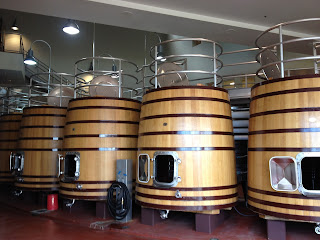Lately I've been hearing a lot about gravity flow winemaking. I first encountered it in South America, having visited wineries in Argentina, Chile and Uruguay that are gravity-driven. The belief is that moving the wine via pumps is disruptive to the wine and steals some of its character. Gravity-driven wineries are constructed on multiple levels so that wine is transported from higher tanks to lower tanks by gravity. Conceivably you could require as many as 4 levels - sorting level for the grapes/juice to go in from the press, a level below for racking off sediment, another level below for racking off fermentation lees, and another level down into the barrel cellar. I was always skeptical - what if you run out of tanks in the lower levels? What about blending? What if you need to move the wine up to an empty tank? And forget logistics of the hoses - there would need to be trapdoors and tunnels everywhere. The mystery was solved during my recent visit to Vineyard 29 in Napa. There I understood the missing link - a holding tank that moves between levels via elevator, since they have just 1 level of tanks above the barrel cellar. With their elevator holding tank they have more flexibility to move the wine without relying on available tanks on a certain level. Hoses are snaked through tunnels in the walls and floor.
Above Tank Level
Tank Level
Holes for the hoses to snake through to reach the Lower Level
Red wine barrels in the cellar
Once we made our way through the gravity tour, we were welcomed in the barrel cellar for a round-table tasting.
Their 2009 Estate Sauvignon Blanc was unlike any I'd ever had. It was luscious, flowery and tropical while also maintaining the acidity and minerality so coveted in Bordeaux. The use of concrete tanks allows for an air exchange that makes the wine less sensitive to oxidation, so it can age for longer than most white wines - it was aged for 18 months in water-soaked oak barrels (minimal toast) before bottling. This wine was so complex and alive, yet refined and pretty. The finish was super long.
Concrete holding tank for the Sauvignon Blanc
The 2008 Aida Cabernet Sauvignon was blended with small amounts of Merlot and Petit Verdot. It was jammy and thick with super dark blueberry fruit. It was quite balanced in terms of tannin, acidity and alcohol - which was 14.8% but the wine didn't taste hot.
The 2009 Estate Cabernet Franc (75% Cab Franc/25% Cab Sauv) was also unlike any I'd ever had. It had a gorgeous rose/graphite/leather nose with an earthy spice and marked minerality on the palate. Not a ton of fruit but I did notice dark plum. It was very rich and complex with a long finish.
All the wines were decanted 1 hour before serving
Thanks again to Austin for a truly memorable experience - I look forward to enjoying the wines I took home.








No comments:
Post a Comment